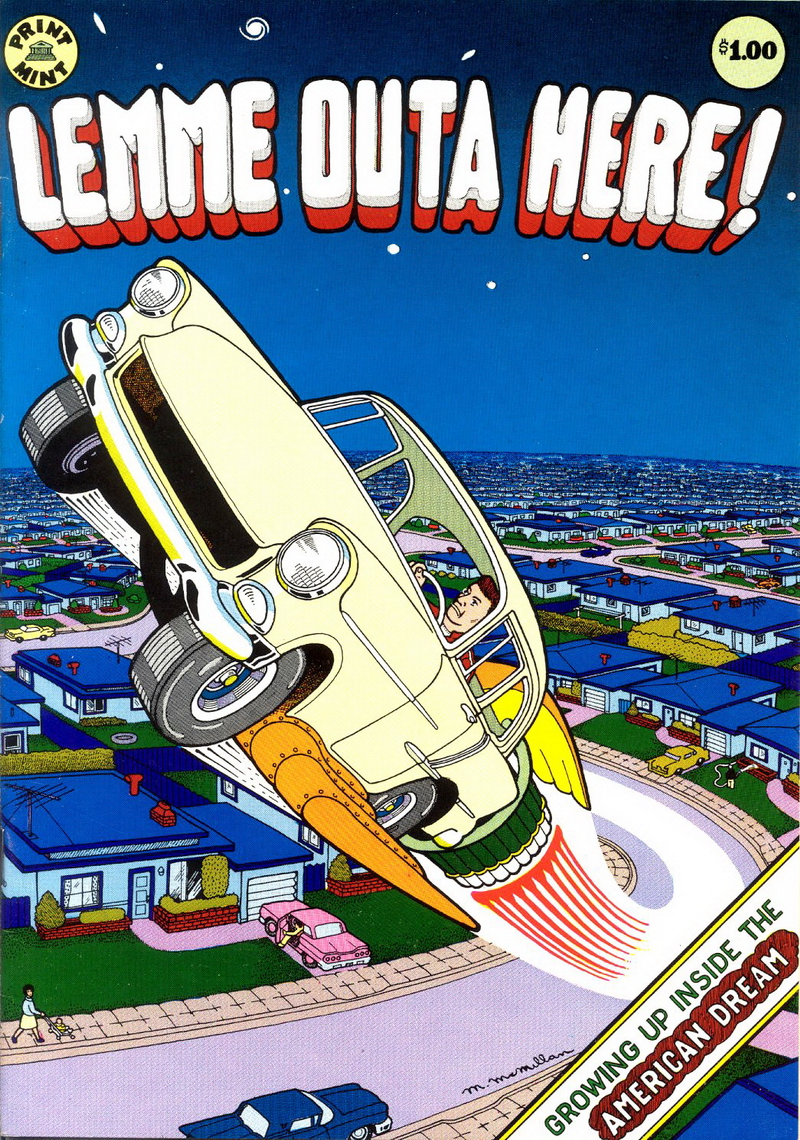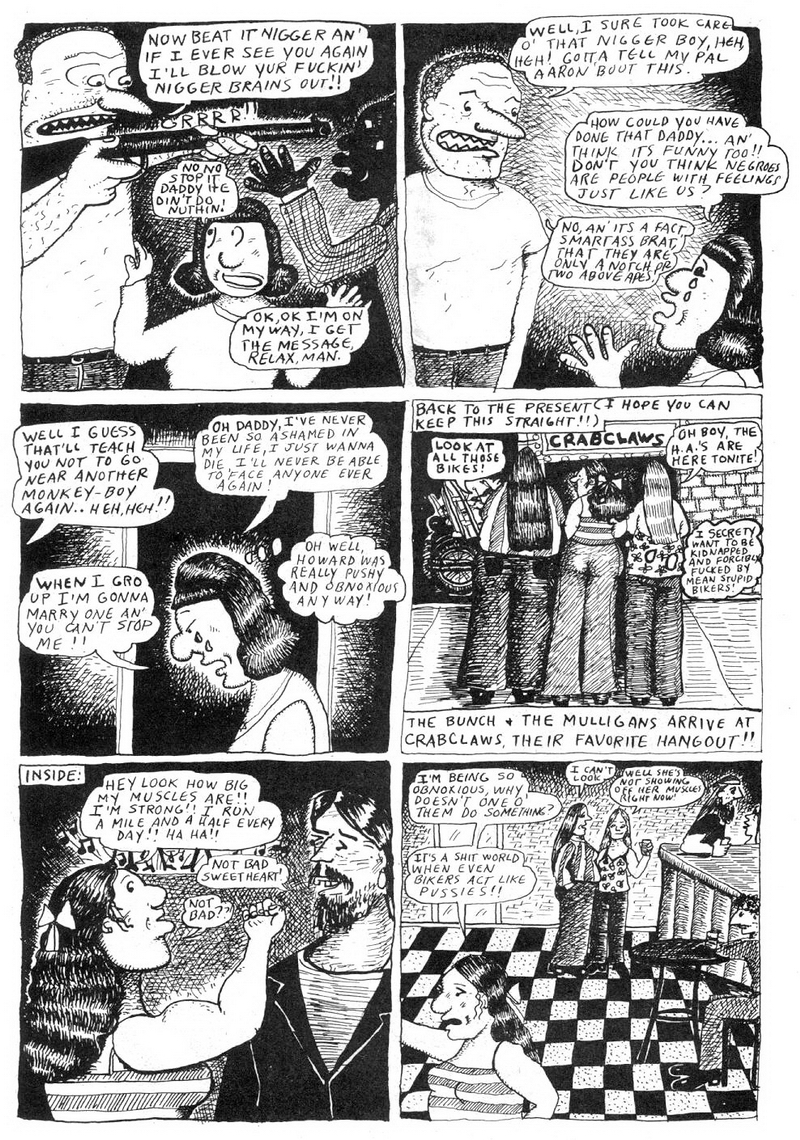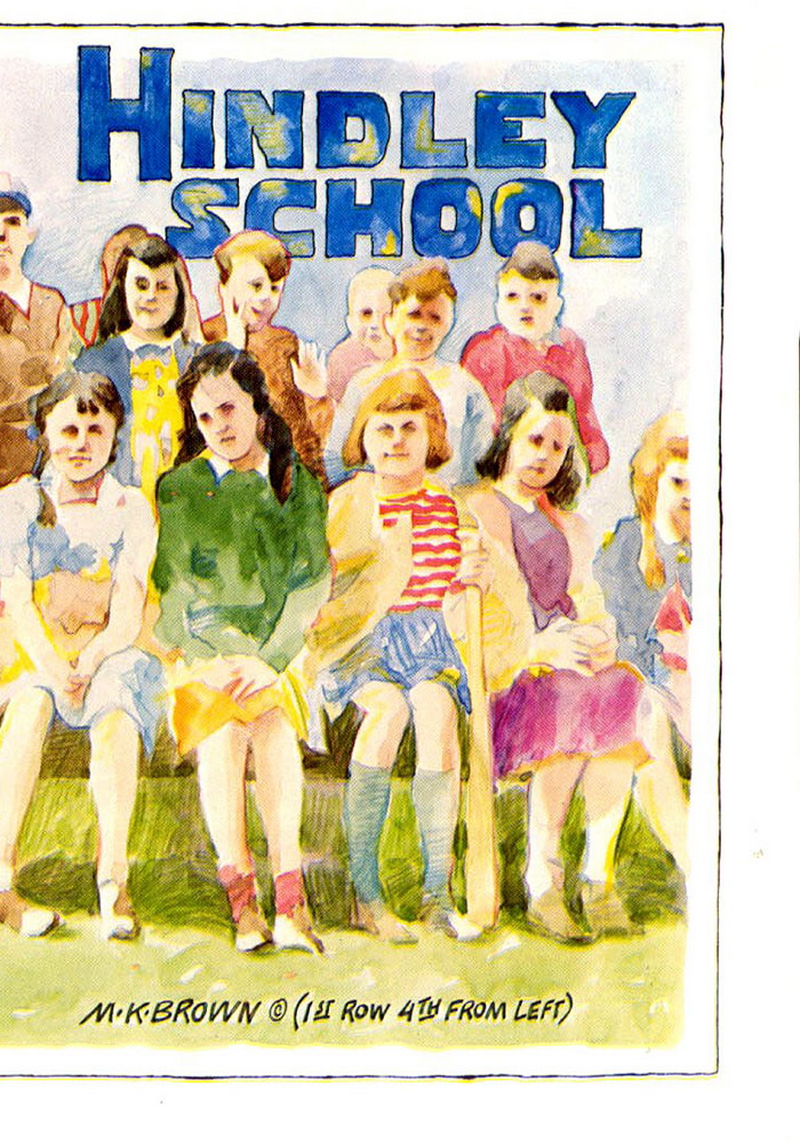lemme out of here

Print Mint October 1978
Lemme Outa Here! features features a handful of cartoonists conveying stories about life in the suburbs from the late 1940s to the ’60s. Diane Noomin, who edited the book and provided a funny DiDi Glitz story, stated the comic has “a theme of growing up in suburbia, growing up in America, and wanting to escape that.”
Noomin’s husband Bill Griffith opens the book with “Is There a Life After Levittown?”, a terrific four-pager about his youth in a suburb of New York. Whenever I read stories like this from Griffith, I wish he had spent more time exploring “real life” than the absurd world of Zippy the Pinhead and his non-stop non-sequiturs. But who the hell am I to question the enormous success Griffith has earned with Zippy? I would’ve done the same if I were him.
Robert Crumb provides a two-page snippet about his childhood friends (including his brother?) playing Treasure Island pirates and burying fake treasure on the beach in Oceanside, California. Crumb excels at portraying this type of story with accurate details, evoking a sense of nostalgia about the innocence of youth without becoming saccharine.
Aline Kominsky contributes a sweeping nine-page story about her stay at a sleepaway camp in New Jersey back in 1962. “Oh Camp So Dear” begins by exploring the awkward need of fitting in with teenage peers before careening off on a tangent about when she dated a black boy and her dad embarrassed her. She also pops back to the present day (in ’78) when she and a couple pals visit a biker bar and the Bunch (Kominsky) gets drunk and fucked in the ass on a one-night stand. Kominsky knows she’s bouncing all over the map (even stating, “I hope you can keep this straight!”), but circles back to the sleepaway camp at the end. Like all Kominsky comics, she sustains no sense of privacy or false decorum about her life, which helps the reader feel like an intimate confidante of hers and laugh with her instead of at her.
Diane Noomin’s signature character DiDi Glitz shows up with her sister Glenda and mother Irma for “I’d Rather Be Doing Something Else,” which features Glenda recalling her youth with DiDi while she babysits DiDi’s daughter, Crystal. It takes careful reading to track the jumping back and forth in time as Noomin describes two decades of life shared by Glenda and DiDi, but it’s well worth the effort as she amusingly documents the enduring bond between two sisters.
Kim Deitch and Justin Green also provide stories. Deitch’s six-pager about an old-TV-show fan club is quite funny and Green’s allegory about Binky Brown trying to escape his miserable adolescence (by escaping from his dog, Nostalgia) is just okay. Robert Armstrong and Mark Beyer chip in a one-pager each on the inside covers and they illuminate stark differences between the authors’ childhoods (poor Beyer!).
By 1978, autobiographical comics by underground creators were relatively common, having been pioneered by Green, Crumb and Harvey Pekar, but there was still new ground to be broken. Lemme Outa Here! provides a format for multiple stories by different artists that explore a single theme, similar to Wimmen’s Comix but open to both genders. It also focuses on childhoods in suburbia, a topic frequently visited in fiction but not deeply explored in comic books, beyond Green’s grim recounting in Binky Brown Meets the Holy Virgin Mary. Lemme Outa Here! helped set the stage for exploring childhood (especially troubled childhoods) in comic books that would follow.
Lemme Outa Here! and Human Drama were the last comic books published by The Print Mint, a legendary underground publisher (Moondog #4 was officially “published” by The Print Mint in 1980 but actually printed and distributed by Last Gasp). In hindsight, the demise of The Print Mint was inevitable by the early ’70s, when founders Don and Alice Schenker agreed to split the business with partners Bob and Peggy Rita. The Schenkers took the retail poster store and the Ritas assumed the publishing and distribution business, which struggled until they went out of business in 1978. The Ritas’ penchant for printing almost anything that struck their fancy, as well as the expensive experiment with Arcade, led to their downfall. The Schenkers’ poster shop continued until 1985, when they sold the store. According to Wikipedia, the shop is still in business, but I could not track down any online presence for it.
Michael McMillan – 1 • Robert Armstrong – 2 • Bill Griffith – 3-6 • Robert Crumb – 7-8 • Aline Kominsky – 9-17 • Kim Deitch – 18-23 • Justin Green – 24-25 • Diane Noomin – 26-34 • Mark Beyer – 35 • Mary K. Brown – 36





































